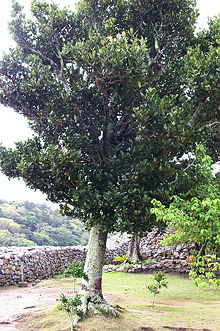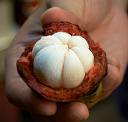Garcinia
This article needs additional citations for verification. (December 2014) |
| Garcinia | |
|---|---|

| |
| Garcinia subelliptica, known as fukugi in Japan | |
| Scientific classification | |
| Kingdom: | Plantae |
| Clade: | Tracheophytes |
| Clade: | Angiosperms |
| Clade: | Eudicots |
| Clade: | Rosids |
| Order: | Malpighiales |
| Family: | Clusiaceae |
| Tribe: | Garcinieae |
| Genus: | Garcinia L. |
| Species | |
|
At least 50, see text | |
| Synonyms | |
|
Brindonia Thouars | |
Garcinia is a plant genus of the family Clusiaceae native to Asia, America, Australia, tropical and southern Africa, and Polynesia. The number of species is highly disputed, with various sources recognizing between 50 and about 300. Commonly, the plants in this genus are called saptrees, mangosteens (which may also refer specifically to the purple mangosteen, G. mangostana), garcinias or, ambiguously, "monkey fruit".
Many species are threatened by habitat destruction, and at least G. cadelliana from South Andaman Island is almost or even completely extinct already.[1]
The fruits are a food source for several animals, such as the archduke butterflies (Lexias) of tropical eastern Asia which relish the sap of overripe mangosteens.
Description
Garcinia species are evergreen trees and shrubs, dioecious and in several cases apomictic. The fruit is a berry with fleshy endocarp,[2] which in several species is delicious.
Uses

The fruit of most species of Garcinia are eaten locally; some species' fruits are highly esteemed in one region, but unknown just a few hundred kilometres away. The best-known species is the purple mangosteen (G. mangostana), which is now cultivated throughout Southeast Asia and other tropical countries, having become established in the late 20th century. Less well-known, but still of international importance, are kandis (G. forbesii) with small round red fruits with subacid taste and melting flesh, the lemon drop mangosteen (G. intermedia) with yellow fruit that look like a wrinkled lemon, and the thin-skinned orange button mangosteen (G. prainiana).
In addition, mangosteen rind (exocarp) extract is used as a spice. It figures prominently in Kodava culture, and G. multiflora is used to flavour and colour the famous bún riêu soup of Vietnam, where this plant is known as hạt điều màu. Garcinia gummi-gutta yields a spice widely used in South Asia, in particular in Kerala, where it is called kodumpulli.
Most species in Garcinia are known for their gum resin, brownish-yellow from xanthonoids such as mangostin, and used as purgative or cathartic, but most frequently – at least in former times – as a pigment. The colour term gamboge refers to this pigment.

Extracts of the exocarp of certain species – typically G. gummi-gutta, but also purple mangosteen – are often contained in appetite suppressants, but their effectiveness at normal consumption levels is unproven, while at least one case of severe acidosis caused by long-term consumption of such products has been documented.[3] Furthermore, they may contain significant amounts of hydroxycitric acid, which is somewhat toxic and might even destroy the testicles after prolonged use.[4]
Bitter kola (G. kola) seeds are used in folk medicine.[5] G. mannii is popular as a chew stick in western Africa,[6] freshening the breath and cleaning the teeth.
G. subelliptica, called fukugi in Japanese, is the floral emblem of Mobuto and Tarama on Okinawa. The Malaysian town of Beruas – often spelled "Bruas" – derives its name from the seashore mangosteen (G. hombroniana), known locally as pokok bruas.
Selected species



The Plant List currently (July 2017) lists 395 species including:[7]
References
- ^ World Conservation Monitoring Centre (1998). "Garcinia cadelliana". The IUCN Red List of Threatened Species. 1998. IUCN: e.T33490A9782233. doi:10.2305/IUCN.UK.1998.RLTS.T33490A9782233.en. Retrieved 12 January 2018.
- ^ Asinelli, M.E.C.; Souza, M.C.o.d.; Mourao, K.t.S.M. (2011). "Fruit ontogeny of Garcinia gardneriana (Planch. & Triana) Zappi (Clusiaceae)". Acta Botanica Brasilica. 25 (43–52).
- ^ Wong, Leslie P; Klemmer, Philip J (2008). "Severe Lactic Acidosis Associated with Juice of the Mangosteen Fruit Garcinia mangostana". American Journal of Kidney Diseases. 51 (5): 829. doi:10.1053/j.ajkd.2007.12.043. PMID 18436094.
- ^ Saito, M; Ueno, M; Ogino, S; Kubo, K; Nagata, J; Takeuchi, M (2005). "High dose of Garcinia cambogia is effective in suppressing fat accumulation in developing male Zucker obese rats, but highly toxic to the testis". Food and Chemical Toxicology. 43 (3): 411–9. doi:10.1016/j.fct.2004.11.008. PMID 15680676.
- ^ 20 Super Health Benefits Of Eating Bitter Kola (Garcinia Kola)
- ^ Cheek, M. (2004). "Garcinia kola". The IUCN Red List of Threatened Species. 2004. IUCN: e.T34715A9884648. doi:10.2305/IUCN.UK.2004.RLTS.T34715A9884648.en. Retrieved 12 January 2018.
- ^ The Plant List: Garcinia
External links
 The dictionary definition of 'Garcinia' at Wiktionary
The dictionary definition of 'Garcinia' at Wiktionary Media related to Garcinia at Wikimedia Commons
Media related to Garcinia at Wikimedia Commons Data related to Garcinia at Wikispecies
Data related to Garcinia at Wikispecies
